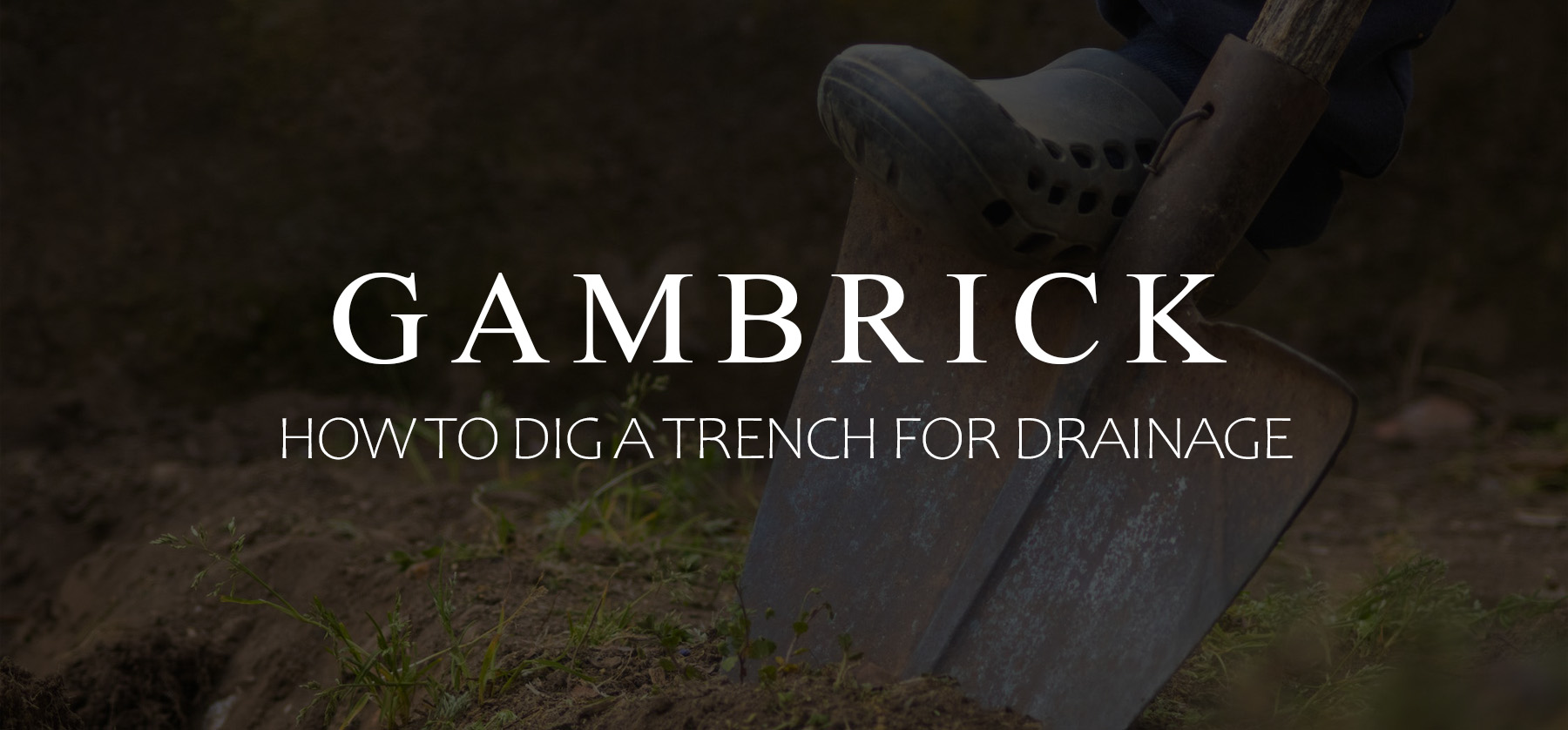How To Dig A Trench For Drainage
Digging a drainage trench is a great way to move water away from your house and around your yard. Most drainage trenches are 8 to 12-inches wide x 12 to 24-inches deep and can be dug by hand or machine. Trenches should slope downhill in the direction you want water to run with a slope of around 1%, which is 1-inch of pitch per 10 feet. Drainage trenching by hand is relatively easy with basic tools as long as the ground isn’t too hard, in which case I use a mini trencher for small jobs and a full-size trencher for larger projects. If you’re digging by hand, you’ll need a level to check the pitch, a tape measure, some stakes, string, a pick-axe, a tamper, a hoe, a saw, and a flat and spade head shovel. A wheelbarrow comes in handy, but you don’t always need one.
Once you’ve got your tools ready, you’ll need supplies. Bring a perforated pipe (the diameter depends on how much water you need to drain, but 4 to 6-inches is standard), gravel, landscaping felt, and some larger stones if you’re finishing the top of the trench with hardscaping.
Here’s how I dig a trench for drainage step by step:
- Design your drainage trench, including its path, depth, slope, pipe size, gravel size, etc.
- Mark the trench path with stakes and string
- Gather your digging tools and trench supplies
- Dig your trench
- Install landscaping fabric
- Pour and tamp down your gravel base
- Install the drain pipe
- Surround the sides and top of the pipe with gravel
- Finish the top of the trench with dirt or large stones
- Remove excess dirt
If you pitch your trench correctly, it should carry water downhill to wherever you need it.
What Are Trench Drains?
Trench drains are also known as channel drains, French drains, or drainage trenches. Their purpose is to collect and move water from one place to another. For this reason, drainage trenches are pitched downhill in the direction you want the water to run at a slope of 1%, which is about 1-inch per 10-feet of run. Trench drains are typically located near a house or other structure, at the end of a downspout, or in areas prone to flooding or pool water.
- Trench drains redirect water from areas where it presents a potential problem, such as near a foundation or where it can pool and cause erosion.
- A trench drain can be fed into a sewer, waterway, or area that can handle the water.
Trench drains are usually a 4 to 6-inch solid or perforated pipe buried inside an 8 to 12-inch wide x 12 to 24-inch deep trench filled with gravel.
When the drain uses a perforated pipe, water drains as it runs through it. When a solid pipe is used, all the water entering the pipe drains to a single location. Generally, solid pipes feed into a sewer or similar system that can handle large amounts of water.
For most residential trench drains, perforated pipes work better because they disperse water evenly along the entire trench path.
Step 1. Design Your Drainage Trench
The purpose of a drainage trench is to move water from one area to another. Properly designing your trench is essential if you want it to function effectively. The first step in digging a trench drain is the design. Every property is different, so your drainage trench needs to be tailored to the slope of your yard, how water runs, where it pools, soil conditions, where you want water to go, and how much water you need to move.
Based on the topography of your land, you can plan out the path of your trench.
- Start by determining how water runs on your property and where it pools.
- Then, decide where you want the water to go.
- Based on where water pools, how it travels, and where you want it to go, you can plan a path for your trench.
- If water pools in several areas, including catch basins feeding into a central trench drain.
- I use a copy of the property survey or a topographical map to draw the path of my drainage trenches on paper. I then use the drawing as a blueprint when marking the trench.
Once the path of your drainage trench is designed, figure out how much water you need to move. Based on the amount of water, choose a drainage pipe size. A 4 to 6-inch diameter perforated drainage pipe is standard.
Select a size that works with your diameter pipe if you need catch basins.
Once you determine the size of your pipe, it’s time to design the trench dimensions. Drainage trenches are generally 8 to 12-inches wide x 12 to 24-inches deep with a slope of 1%, which is 1-inch per 10 feet. However, more pitch can help drain it faster if you get lots of water.
How To Chose The Right Drainage Trenching Pipe
Buried inside most drainage trenches is a drain pipe. When designing a drainage trench, you not only need to determine the size of the pipe but also the type. Drainage pipes come in two primary forms, solid and perforated.
- A solid pipe moves all the water funneled inside one end of the pipe to the other. Solid pipes can be flexible or rigid. The problem with solid pipes is that water can freeze inside if it’s not below the frost line.
- A perforated pipe has drain holes every few inches along the entire pipe. Water drains out of the pipe as it flows from one end to the other. A perforated pipe can either be rigid or flexible. Water is less likely to freeze inside a perforated pipe, no matter the depth, because of the drain holes.
When designing your drainage trench, you must decide if you want all the water to drain to a single location or dispersed along the pipe’s path.
Over the last 25 years working as a home builder, I’ve dug hundreds of drainage trenches, and there’s no single best type of pipe. Both perforated and solid drain pipes work fine; which design is best depends on your soil conditions and how much water your yard receives.
A combination of pipes can also be used. On many jobs, I’ve used a solid pipe near the house with a perforated pipe as the trench gets further away. This minimizes how much water drains into the ground close to the house but disperses water as the pipe gets further away.
Step 2. Mark The Trench Path
Step 2 in drainage trenching is marking the trench’s path. Based on the design you came up with in Step 1, transfer your trench’s path from paper to the ground as accurately as possible. This is where drawing your trench on a scale copy of your property survey or topographical map can help.
To accurately mark your trench’s path, it helps to measure off of a reference point on your survey. This can be the edge of the property, a fence, a house, a shed, a path, etc.
Drive stakes into the ground every few feet along the trench’s path. Then tie a string to the stakes. Keep your stakes about a foot from the trench so you’ll have plenty of room to dig.
When digging a trench by hand, you need less space than when using machines. For example, full-size trenchers can be 3 feet wide and need lots of room to maneuver. In this case, you should keep the string line farther from the trench.
- Use your trench to direct water flow downhill, away from flooded areas or your home.
- Your trench does not need to be straight.
- You can design a drainage trench with curves if the slope remains consistent.
- Aim for at least a one-inch slope for every ten feet of run.
If you don’t have stakes and string, a trench path can be marked with paint. However, I prefer using stakes and string because it’s more accurate and doesn’t wash off or erase itself when the grass grows.
Step 3. Gather Digging Tools & Trench Supplies
Drainage trenching requires tools to mark the trench’s path, digging tools, and various landscaping supplies. The purpose of a drainage trench is to move water, so you need to do more than dig.
Here’s a list of tools you’ll need if you’re digging by hand:
- Level to check the trench’s pitch
- Tape measure
- Stakes & string or paint
- Pick-axe
- Tamper
- Hoe
- Flat & spade head shovel
- Saw
- A wheelbarrow comes in handy, but you don’t always need one
If you’re digging the trench by machine, you’ll need a trencher. They come in a few different sizes; my favorite is a mini trencher on wheels. They’re easier to maneuver than full-size trenchers and easier to handle than a hand-held mini-trencher.
Once the trench is marked and dug, you’ll need the following supplies to build the trench:
- Perforated or solid pipe (the diameter depends on how much water you need to drain, but 4 to 6-inches is standard)
- Gravel (I use 1/2-inch to 1-inch trap rock).
- Landscaping felt
- Larger stones if you’re finishing the top of the trench with hardscaping.
- Topsoil if you’re finishing the top of the trench with grass.
- Catch basins if you’re using them.
I always have all the tools and supplies I need on-site before starting work. Being prepared saves time and money because you won’t have to run out to the hardware store to buy things during the day.
Step 4. Dig Your Drainage Trench
To dig a drainage trench, you need the proper tools. When digging by hand, I use a pick-axe to break up the top layer of soil and grass. The first few inches are usually the hardest until you reach softer clean dirt. However, if you have rocky soil, clay, or caliche, it could be hard ground to the bottom of the trench.
Use the pick-axe to soften the ground and pry loose large rocks and roots. Then use your spade head shovel to dig out large portions of Earth. As you dig, check your depth with a tape measure.
Digging a trench by machine is much easier than by hand because the trencher does all the work. But you’ll still need a flat-head shovel to shape the trench, pitch the bottom and remove excess dirt.
Don’t use a trencher to dig dirt directly next to your house. I always keep the trencher about a foot away and dig that last 12-inches by hand.
Once you hit the required depth, shape the sides and bottom of the trench with your flat-head shovel. Ideally, you want a trench with a flat bottom and sides with a square shape.
I dig a 4 to 5-foot section of trench first and then start checking my pitch with a level.
The most common drainage trench dimensions are:
- Width: 8–12 inches
- Depth: 12-24-inches
- Slope: 1% or 1-inch per 10-feet
Make sure your trench slopes downward so that water runs away from your home and other structures to places where you want it to go.
Slope The Trench
Making sure the trench is sloped correctly is more important than other factors like its depth, width, the gravel you use, and the path it follows. Without the correct slope, water won’t drain away from your home, and the trench will be ineffective. For water to drain properly, your drainage trench must slope downwards at least 1% or 1-inch every 10 feet of length.
It’s very important to slope the entire drainage pipe. If sections of the pipe back-pitch or become level, you could get standing water inside the pipe.
As you dig down and shape the trench, check the pitch with a level. The longer the level, the more accurate it will be. When I dig drainage trenches, I check with a 3-foot level first and then switch to a 6-foot framing level once my trench gets bigger.
Because of the slope, a trench will be deeper at the outlet vs. the drain’s beginning. For example, a 100-foot trench with a 1% slope is 10 inches deeper at the outlet than at the start. That’s a lot more dirt to dig. Keep this in mind when pitching your trench.
How To Determine The Slope Of Your Yard
Knowing the slope of your yard can help you pitch the trench properly. Once you know how the yard slopes, you can measure down with a tape measure to pitch the bottom of your trench.
Determining the pitch of your property can be done with stakes and string, a laser, or a long level. A laser transom is very accurate, but most people don’t own one. Stakes and string can be just as accurate as a laser, but they take a lot more work. A level is the least accurate over long distances but works great on short runs.
Here’s how to do it with stakes and string:
- Drive two stakes into the ground a few feet apart, starting where the trench begins.
- Drive stakes every few feet along the entire trench path.
- Tie a string between stakes using a small line level to level the line.
- Make sure the string is level from the first stake to the last.
- When you’re done, you should have a long-level string running from the first stake to the last.
Once your stakes and leveling string are in place, you can measure from the string to the ground to determine its slope. This knowledge can help you pitch the bottom of your trench.
When the trench slopes 1-inch every 10 feet of run, water will naturally drain in the direction of the slope. Pitching the trench steeper than 1-inch per 10-feet drains water faster. This can be helpful if you’re dealing with lots of water.
Step 5. Install Landscaping Fabric
Now that your trench is dug and properly pitched, line the bottom and sides with water-permeable landscaping fabric. The most common sizes for landscape fabric are 3.2 oz. and 5 oz. 3.2 oz is a ground cover that’s made to withstand UV rays and lasts longer in direct sunlight. 5 oz. is a weed barrier that’s meant to be covered with rock or mulch. What you want for a drainage trench is 5 oz. or thicker.
Landscape fabric will help prevent grass and plant roots from growing inside your trench. This is a much bigger problem if you use a perforated pipe because weeds can grow inside the pipe and block water flow.
Invasive roots can destroy a drainage ditch and clog the pipe.
It’s very important to use water-permeable fabric and not solid plastic. Water-permeable fabrics allow water to drain through them but solid plastics don’t. If you line your trench with something solid, water will become trapped inside the trench with nowhere to drain.
Step 6. Pour A Gravel Base
Pour at least 3 to 4-inches of gravel into your trench on top of the landscape fabric. Use a hoe to spread the gravel evenly. Check the gravel’s pitch with your level. It’s very important to maintain your trench’s pitch after the gravel is poured because the drain pipe will be installed directly on top of the gravel in the next step.
Once the gravel is level and even, tamp it down. This is also an important step because you don’t want the gravel settling after the pipe is laid. If you don’t tamp the gravel base down before laying your pipe, it could settle unevenly which could affect the pitch of your drain pipe.
- Pro Tip: Spray some water onto the gravel as you tamp it down. This helps the rock settle which creates a stronger base.
I use 1/2 inch to 1-inch gravel. Irregularly shaped rock is better than smooth round gravel because there’s more open space for water to drain. My favorite is called trap rock or crushed stone.
Gravel creates a solid base for your pipe and allows water to seep out of the pipe and into your soil. It also allows groundwater to naturally drain from the surface to the soil below the trench.
Step 7. Install The Drain Pipe
Lay your drain pipe into the trench directly on top of your gravel base. If you’re using a French drain with a catch basin or surface grate, now is the time to install those along with your pipe.
The two types of pipes used for drainage trenches are:
- Perforated Pipe: A perforated pipe has drain holes every few inches along the pipe. It allows water running through the pipe to drain out of the holes and into the soil. This prevents all the water from draining to a single location.
- Solid Pipe: A solid pipe carries water to a single location. Since there are no drain holes, solid pipes funnel more water than perforated pipes. For this reason, you should only use them if you’re diverting water into a sewer or other area that can handle large amounts of water.
Check the pipe’s pitch when you place it onto the gravel bed. This is the last time you’ll be able to correct the pitch if it’s off.
Using French drains or catch basins with a surface grate is a good way to collect water in areas of your property that pool. I like to install them near the foundation of the house, by gutter downspouts, in flood-prone areas, or in areas that pool lots of water.
Step 8. Cover The Pipe With Gravel
Pour gravel along both sides and the top of your drain pipe. Pour carefully so you don’t disturb the pipe as you cover it with gravel. Ideally, you want another 3 to 4 inches of gravel on top of the pipe.
Depending on how you plan on finishing the surface of your trench, you need to leave a few inches between the top of the gravel and the surface. For example, if you’re planting grass on top of the trench, leaves about 4 inches of space between the gravel and surface for topsoil.
Cover it with more landscape fabric once you’ve poured gravel on top of the pipe. This creates a tube of fabric around the entire trench, which helps keep weeds away from the pipe.
Step 9. Finish The Top Of The Trench
Based on how you plan on finishing the surface of your trench, you need some room between the top of the gravel and the surface. If you’re planting grass, leave about 4 inches for topsoil. But if you finish the top layer with large stones, you only need 1 to 2 inches of space.
Step 10. Remove Excess Dirt
The last step is removing excess dirt and cleaning the area. Use a shovel and wheelbarrow to remove large piles of dirt and grass, or break them up with your hoe or a rake and spread them around the property. Because of the pipe and gravel, you’ll have lots of excess dirt from digging. Make sure to have a plan for dealing with it all.
On most jobs, I use the excess dirt to fill uneven areas of the yard and sinkholes. But if the property is already graded, you must haul the dirt away. If you have a pickup truck, a dirt dumpster, or the local landfill is an excellent way to deal with it.
Is Drainage Trenching Dangerous?
Drainage trenching can be dangerous if you’re not careful. It’s hard work even if you use a machine, and it can easily strain your back and other muscles. Because of the pitch, even shallow trenches can get deep when the run is long. For example, a 12-inch deep trench with a 100-foot run will be 24-inches deep when it ends. Every cubic yard of soil you remove can weigh around 3,000 lbs, and a trench can easily require a ton of gravel.
Be careful of cave-ins and falling in the trench. I’ve seen plenty of sprained and twisted ankles because the side walls of a trench collapsed.
Be very careful when working with trenchers. Drainage trenching is relatively safe when digging by hand, other than the risk of some minor injuries, but digging with machines can cause serious harm. Keep loose clothing and your body away from the trenching blade at all times.
Trenchers are very powerful machines that can be dangerous to operate if you don’t know how. If you’re inexperienced using them, I recommend digging your drainage trench by hand.
How Deep Should A Trench Drain Be?
A drainage trench should be at least 12 to 24-inches deep with an average depth of 18-inches. This is enough depth for a 3 to 4-inch gravel bed, a 4 to 6-inch drain pipe, 3 to 4-inches of gravel on top, and a finish layer of stone or topsoil.
How Wide Should A Drainage Trench Be?
A drainage trench should be 8 to 12-inches wide, which is the average width of a flathead shovel. This provides enough room for a 4 to 6-inch diameter drainage pipe surrounded by a few inches of gravel.
What’s The Best Size Drainage Pipe For A Trench?
A 4 to 6 -inch diameter pipe is the best size for a drainage trench. The pipe can be solid or perforated depending on how much water you’re moving, soil conditions, and where you’re draining the water. A solid pipe may be a good solution if the water drains into a sewer or similar system. However, most French drains use a perforated pipe.
Keep the following tips in mind:
- Water inside solid pipes can freeze if not below the frost line.
- Water inside a perforated pipe is less likely to freeze no matter the depth because it can drain out.
- Smaller diameter pipes are easier to clog and can’t handle heavy water.
- Solid pipes are less likely to be damaged by weeds because they have no holes to penetrate into.
Choosing the right size and type of pipe for your trench drain is essential if you want it to function correctly. When in doubt, use a bigger pipe. Using a pipe too big won’t affect how it drains the water, but using a pipe too small can cause a clog or backed-up pipe.
What Are The Best Tools To Dig A Drainage Trench?
The best tools to dig a drainage trench are basic hand tools like a spade and flathead shovel, pick axe, and hoe. You’ll also need a tape measure to check the depth and width of your trench and a level to make sure it’s pitched correctly.
The machine tool for digging a trench is a trencher. They’re very powerful and can quickly dig a trench in minutes. However, you should not use a trencher right up against a foundation, so you’ll still need basic digging tools when using one. You’ll also need a tape measure and level to check the trench’s dimensions and pitch.
Other tools can also come in handy. Whenever I dig trenches, I always bring string, stakes, a line level, a hammer, and a wheelbarrow.
Why Are Drainage Trenches Important?
Drainage trenching is essential because it helps deal with excess water that can damage a foundation or cause erosion. Water mitigation is an important component of building a new home or managing land. If you live in an area that sees heavy rainfall or snow, you need a plan to deal with water. Drainage trenches can be a big help because they collect and divert water when designed and built correctly.
- A French drain is The most common type of drainage trench. They’re typically installed along the foundation of a house to keep excess water away from the foundation. This can prevent the undermining of your footing and foundation damage.
- Another common area to install a drainage trench is at the bottom of your downspouts. Collecting and diverting water from downspouts helps protect the foundation of your house.
- Drainage trenches are very helpful if your property’s topography creates areas of pooled water. A trench drain and some grates can collect that water and funnel it to other areas.
Drainage trenches are essential because they help manage large amounts of water. When building a new home or structure of any kind, you should always take water into consideration if you live in n area that receives heavy rainfall or snow.
Do Drainage Trenches Require A Permit?
Whether or not a drainage trench requires a permit depends on where you live and the type of trench you’re building. The most significant factor to consider is where the trench drains. In most locations, a drainage trench leading from your downspouts to a garden or a standard foundation French drain does not need a permit. However, you should still check with your local building department to be sure.
Drainage trenching that leads to a sewer, lake, stream, or other public waterway or land may require a permit.
I recommend constantly checking with your local building department or land use office to determine whether a permit is required. And always call before you dig to ensure you don’t hit an underground utility line.
How To Keep A Trench From Collapsing?
If your soil is loose and easily collapses, you must pitch the sides slightly instead of making them vertical. This is called benching the soil in excavation. The angle I use is obtuse at around 110 degrees. The looser the soil, the wider your angle must be to prevent a collapse.
For severely loose soil, you can prevent a collapse by shoring the sides with either metal or wood. For small trenches, cut pieces of plywood supported by stakes driven into the ground works best. When shoring a drainage trench, I generally dig the trench about 12-inches wider on both sides, so I have room to install the shoring and remove it after the gravel and pipes are installed.
Digging A Trench To Drain Water
A drainage trench is a great way to collect and divert large amounts of water away from your home or areas of the yard that pool water. To dig a drainage trench, follow these simple steps:
- Plan your drainage trench’s width, depth, slope, pipe, and path. Start at the problem area and use the trench to direct water to another location.
- Create a slope of at least 1%, which is about 1-inch per 10-feet of run.
- Mark your trench path with paint or stakes and line.
- Dig the trench. It should be 12 to 24-inches deep and 8 to 12-inches wide.
- Line the bottom and sides of your trench with water-permeable landscape fabric of at least 5 oz.
- Pour 3 to 4-inches of gravel into the bottom of the trench and tamp it down.
- Install your drain pipe on top of the gravel. Use either solid or perforated pipe.
- Check to make sure the pipe is pitched correctly.
- Cover the sides and top of your drain pipe with gravel and cover it with landscape fabric.
- Leave space between the top of your gravel and the surface for finish materials like topsoil or large stones.
- Cover the trench with stones, pavers, or soil and grass.
By following these steps, you can create a drainage trench that protects your home from flooding by effectively managing water.
The pitch is the most important thing to remember when creating your drainage trench. If the pipe isn’t pitched correctly, water won’t flow where you want it to, could become stagnant, or could flow back to the house. Make sure to check the pipe’s slope before covering it with gravel.
Summary: How To Dig A Trench For Drainage
Digging a drainage trench is a great way to move water from one place to another. Most drainage trenches are 8 to 12-inches wide x 12 to 24-inches deep and can be dug by hand or machine. Trenches should slope downhill in the direction you want water to run with a slope of around 1%, which is 1-inch of pitch per 10 feet. Drainage trenches can be dug either by hand or machine.
If you’re digging by hand, you’ll need the following:
- Level to check the pitch
- Tape measure
- Stakes & string or paint
- Pick-axe
- Tamper
- Hoe
- Flat & spade head shovel
- Saw
- A wheelbarrow comes in handy, but you don’t always need one
Once you’ve got your tools ready, you’ll need the following supplies:
- Perforated or solid pipe (the diameter depends on how much water you need to drain, but 4 to 6-inches is standard)
- Gravel
- Landscaping felt
- Larger stones if you’re finishing the top of the trench with hardscaping.
Here’s how I dig a trench for drainage step by step:
- Design your drainage trench, including its path, depth, slope, pipe size, grave size, etc.
- Mark the trench path with stakes and string
- Gather your digging tools and trench supplies
- Dig your trench
- Install landscaping felt
- Pour and tamp down your gravel base
- Install the drain pipe
- Surround the sides and top of the pipe with gravel
- Finish the top of the trench with dirt or large stones
- Remove excess dirt
If you pitch your trench correctly, it should carry water downhill wherever needed.
If you have any questions or comments about drainage trenching, email any time.





















